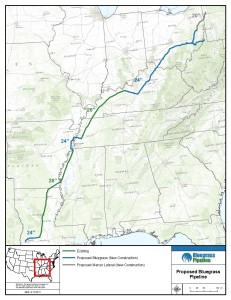Bluegrass Pipeline for Fracked Natural Gas Halted
The business behind hydraulic fracturing for natural gas has become a hot button issue in the more recent years, but natural gas pipeline projects often get less attention.
 The Bluegrass Pipeline was to be built in order to transport natural gas liquids (NGLs) from the Utica and Marcellus shale regions down to the Gulf Coast. The Bluegrass Pipeline is a joint project by Williams and Boardwalk Pipeline Partners, LP, two of the nation’s leading energy infrastructure companies. As it is proposed, the completed pipeline will transport at a rate of up to 200,000 barrels of NGLs per day. The company was to start by building and repurposing approximately 600 miles of the 1,200 mile pipeline. It would begin in Pennsylvania and travels through Ohio, Kentucky, Tennessee, Arkansas, Mississippi and Louisiana.
The Bluegrass Pipeline was to be built in order to transport natural gas liquids (NGLs) from the Utica and Marcellus shale regions down to the Gulf Coast. The Bluegrass Pipeline is a joint project by Williams and Boardwalk Pipeline Partners, LP, two of the nation’s leading energy infrastructure companies. As it is proposed, the completed pipeline will transport at a rate of up to 200,000 barrels of NGLs per day. The company was to start by building and repurposing approximately 600 miles of the 1,200 mile pipeline. It would begin in Pennsylvania and travels through Ohio, Kentucky, Tennessee, Arkansas, Mississippi and Louisiana.
One of the largest environmental concerns involves the pipeline spurs from Kentucky. The land that the pipeline will be built on has limestone karst geology that carries water through caves. In the past there have been problems with pipelines running underneath the ground such as massive sinkholes and pipe explosions, and by building the Bluegrass Pipeline in the territory they are subjecting the residents that live on that very sensitive part of the land to possible danger and a great destruction of the land.
The construction of the pipeline has been halted due to a lack of customer commitment. Along the Gulf Coast there are many regions from which customers could purchase natural gas, so it would be might be more expensive to transport the NGLs from the north to the south than to just pull from closer sights like the Eagle Ford and Barnett shale regions in Texas.
Texas has played a major role in the natural gas industry for many years. Currently, Texas is the highest ranked natural gas consuming state and 58,600 miles of natural gas pipelines within the state, according to the U.S. Energy Information Administration.
With such deep roots in the fracking industry, it is understandable that many in Texas wants to keep it here – it brings jobs and money into the state. However, our water supplies are taking a large hit from this industry. They become contaminated by the chemicals used in hydraulic fracturing procedures such as lead, uranium, mercury, ethylene glycol, radium, methanol, hydrochloric acid and formaldehyde and we drink from that contaminated water supply.
Fracking is the process by which dangerous chemicals are mixed with large quantities of water and sand are injected into wells at extremely high pressure which causes a major water contamination problem. In Texas alone there have been more than 2,000 reported cases of groundwater and private well contamination and more than 1,200 reports among other states within the last five years. They range from allegations of short-term diminished water flow to pollution from stray gas and other substances. With the current drought problem plaguing many areas of Texas, the issue of water contamination has become more prominent and our water resources more precious.
Many national and local organizations have openly opposed expanded fracking until safeguards are in place to ensure minimal pollution. Until these measures are taken our water supplies, climate and health will suffer.